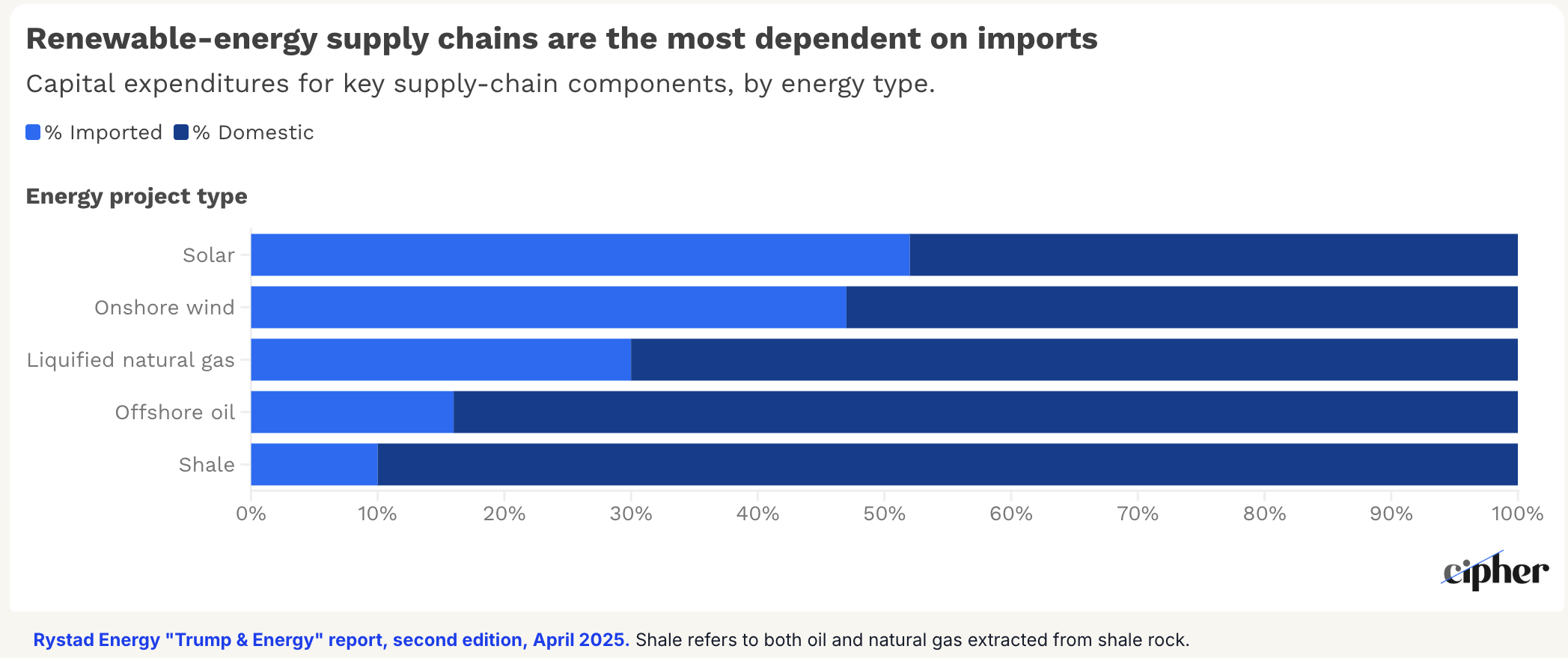President Trump’s tariffs will likely hit the supply chains for wind and solar much harder than supply chains for fossil fuels. Almost all (90%) of capital expenditures associated with extracting oil and natural gas from shale basins was spent on domestically sourced parts, such as piping, while only 48% of capital expenditures associated with solar energy was spent on domestically sourced parts, such as modules and cables. Capital expenditures for offshore oil and gas and liquified natural gas (LNG) facilities are also more dependent on domestic sources than onshore wind and solar, but less so than capital expenditures associated with shale basins. The primary imports for LNG facilities are compressors, valves, and other construction materials, and for offshore oil and gas are piping and cables.

China is currently the dominant supplier of renewable-energy parts, replacing American and European companies by leading the technology development of solar panels 15 years ago. China invested heavily in wind and solar to reduce its dependency on imported fossil fuels, similar to what it is doing in the car market with electric vehicles. Purchasing energy products from China, as with other goods, brings national security risks, which Reuters has recently resurfaced as an issue that should be addressed and is detailed below.
Inherent Security Risk in China-Made Devices
There is also a potential security risk in importing renewable energy infrastructure from China, as unexplained communication equipment was found inside some Chinese-made devices. Rogue communication devices not listed in product documents have been found in some Chinese solar power inverters by U.S experts, who dismantle equipment hooked to grids to check for security issues. Power inverters, which are predominantly produced in China, are used to connect solar panels and wind turbines to electric grids. They are also found in batteries, heat pumps, and electric vehicle chargers. The rogue components provide undocumented communication channels that could help circumvent firewalls and switch off inverters or change their settings remotely. This could destabilize power grids, damage energy infrastructure, and potentially trigger widespread blackouts.
Due to national security concerns, two U.S. Senators introduced the Decoupling from Foreign Adversarial Battery Dependence Act in February. This act bans the Department of Homeland Security from purchasing batteries from some Chinese entities with alleged Chinese Communist Party links, beginning in October 2027. On March 11, the bill was referred to the Senate Committee on Homeland Security and Governmental Affairs. The companies it targets are Contemporary Amperex Technology Company (CATL), BYD Company, Envision Energy, EVE Energy Company, Hithium Energy Storage Technology Company, and Gotion High-tech Company.
Utility companies are expecting similar bans on Chinese inverter manufacturers. In response, some utilities are minimizing the use of Chinese inverters by utilizing alternate sources. Huawei, the world’s largest supplier of inverters, accounted for 29% of global shipments in 2022, followed by fellow Chinese manufacturers Sungrow and Ginlong Solis. The United States has restricted Huawei’s access to U.S. technology since 2019 because of potential risks to national security. Because Chinese companies are legally required to cooperate with China’s intelligence agencies, Chinese-made inverters connected to foreign grids could be at risk of Chinese control.
Although Huawei left the U.S. inverter market in 2019 after its 5G telecoms equipment was banned, it still supplies other Western nations. The European Solar Manufacturing Council estimates that over 200 gigawatts of European solar power capacity is linked to inverters made in China, which is equivalent to more than 200 nuclear power plants. At the end of last year, there were 338 gigawatts of installed solar power in Europe, and illicit control over just three to four gigawatts of Europe’s energy could cause widespread disruption to electricity supplies.
In other industries such as telecoms and semiconductors, regulations have been introduced to mitigate China’s dominance. Decisions regarding whether to secure energy infrastructure are mostly based on the size of the installation. Household solar or battery storage systems fall below those thresholds despite being added to a growing number of households and contributing more energy to the power grid.
Conclusion
President Trump’s tariffs may benefit the United States in ways other than trade due to China placing rogue communication devices in renewable energy parts, particularly inverters, that the country provides to the global marketplace. Trump’s tariffs are affecting wind and solar energy more than fossil fuels because renewable energy requires imports for a greater share of capital expenditures than fossil fuels. While only 48% of capital expenditures for solar power are produced domestically, that number is 90% for shale oil and gas. Trump’s emphasis on domestic energy production and tariffs, therefore, provide security benefits by limiting the amount of “green energy” imports coming from China.